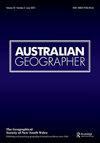将学校学习环境理解为关怀和空间类型学的基础设施
IF 2
2区 社会学
Q2 GEOGRAPHY
引用次数: 4
摘要
澳大利亚教学和学校领导研究所成立于2010年,旨在支持学校和初级教师教育项目的教学质量和领导能力。早期,它制定了七项澳大利亚教师专业标准,影响专业知识、专业实践和专业参与。标准4是专业实践的一部分,要求教师创造和维护支持性和安全的学校学习环境。我们认为,标准4具有地理学家尚未充分考虑的影响,在这里,我们的目标是揭示并研究其潜在的空间性。我们认为支持性和安全的学习环境是至关重要的护理基础设施,可以使用既定的空间类型学使其更加清晰。为了支持这一命题,我们从塔斯马尼亚州政府学校的扫盲教学实践和初级教师教育计划的研究中吸取了经验证据。在这里,我们关注参与者如何描述学校学习环境对学生的教育成就和社会和情感健康的重要性。我们的结论是,空间透镜在思考这些环境时很重要,可以有效地支持教师展示职业生涯中越来越复杂的能力,以感知、使用、创造和帮助他人充分利用这些空间来实现多样化的学习成果。本文章由计算机程序翻译,如有差异,请以英文原文为准。
Making sense of school learning environments as infrastructures of care and spatial typologies
ABSTRACT The Australian Institute for Teaching and School Leadership was established in 2010 to support teaching quality and leadership in schools and initial teacher education programs. Early on it produced seven Australian Professional Standards for Teachers affecting professional knowledge, professional practice, and professional engagement. Standard 4 is part of professional practice and requires teachers to create and maintain supportive and safe school learning environments. We propose that Standard 4 has implications geographers have yet to fully consider, and here our aim is to surface and examine its latent spatialities. We conceive of supportive and safe learning environments as crucial infrastructures of care that can be made more legible using established spatial typologies. To support this proposition, we draw on empirical evidence from a study of literacy teaching practice in Tasmanian government schools and of initial teacher education programs. Here, we focus on how participants described the importance of school learning environments for students' educational attainment and social and emotional wellbeing. We conclude that spatial lenses are important in thinking about these environments and could effectively support teachers to demonstrate career-long and increasingly sophisticated capacities to perceive, use, create, and help others make the most of such spaces for diverse learning outcomes.
求助全文
通过发布文献求助,成功后即可免费获取论文全文。
去求助
来源期刊

Australian Geographer
GEOGRAPHY-
CiteScore
4.10
自引率
8.30%
发文量
33
期刊介绍:
Australian Geographer was founded in 1928 and is the nation"s oldest geographical journal. It is a high standard, refereed general geography journal covering all aspects of the discipline, both human and physical. While papers concerning any aspect of geography are considered for publication, the journal focuses primarily on two areas of research: •Australia and its world region, including developments, issues and policies in Australia, the western Pacific, the Indian Ocean, Asia and Antarctica. •Environmental studies, particularly the biophysical environment and human interaction with it.
 求助内容:
求助内容: 应助结果提醒方式:
应助结果提醒方式:


